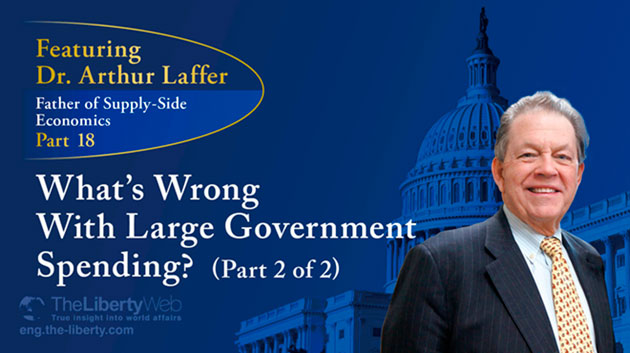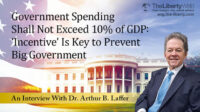What’s Wrong With Large Government Spending? (Part 2 of 2)
The Covid-19 pandemic expanded the national debt of advanced countries. In Japan, the total amount of debt of national and local government exceeded 1.2 quadrillion yen. Supply-side economics places an emphasis on reining in government spending. Continuing from the last interview, Dr. Laffer spoke on the ideal fiscal policy that should be adopted.
Interviewer: Hanako Cho
Cho: Previously, you mentioned that there is a “disassociation” between work and receipt of benefits called the “wedge.”
Dr. Laffer: There is a wedge driven between what it costs to hire a worker and what that worker ultimately receives after all taxes are taken. It is a wedge driven between wages paid and wages received in the economy.
What is the ‘Laffer Wedge’?
Dr. Laffer: Imagine a demand curve for factors of production. It goes from the upper left to the lower right. The vertical axis is price, wage, or rate of return. The horizontal axis is the total GDP of Japan or the U.S. (Note: As the employed population increases, GDP increases and makes a country richer: number of workers x productivity = GDP.) The demand curve goes from the upper left to the lower right of a supply curve for work effort.
The demand for factors of production is downward sloping with respect to real wages paid and real costs for producing. The more it costs the firm to hire a worker, the fewer workers that firm will hire.
The demand curve is predicated upon a firm’s total cost of hiring a worker. That includes all the taxes, contributions for social security, pension fund contributions, new parking lots they have to put in, new regulations. As you lower that cost to businesses, the more people those businesses will want to hire.
Supply Curve of Work Effort
Dr. Laffer: Let me explain the other side of this equation, which is the supply curve. The more a worker receives for working, net, the more that worker is willing to work. The supply curve is driven by the wage the worker receives after tax. This is the very incentive for workers to work.
That after-tax wage comes from two considerations. If I don’t work, how much does the government pay me? If I do work, how much do I make after tax from my employer?
If the tax goes up, my after-tax return goes down. If welfare payments go up, my after-tax rate of return compared to not working goes down.
The more the worker receives net after-tax wages, exclusive of payments for unemployment benefits, welfare payments, food stamps and retirement benefits that the government pays people not to work to do, the more willing that worker is to work. In other words, the lower welfare payments and taxes are, the more willing the worker is to work because that is what the worker receives after tax and, in comparison to, welfare.
The supply curve of work effort goes from the lower left to the upper right. The supply of work effort rises with respect to real wages received, exclusive of unemployment benefits, and it goes down with respect to the demand for labor. This supply curve is predicated upon tax rates and welfare benefits for not working.
Now, I am at 60,000 feet looking at the economy with one demand curve and one supply curve, and I know there is a lot of complication, intricacies and confusions going on.
But this is the truth of an economy.
Back in the ‘70s before the Laffer curve, that is what was called the Laffer wedge in economics. It is the wedge that the government drives between what it costs a firm to hire a worker and what that worker receives in net.
The wedge includes all the transfer payments for not working. It includes all the taxes paid by the businesses to the government for hiring workers, and it includes all the regulations and restrictions. It is an all-encompassing anti-growth set of policies by the government that affects the wedge.
It affects the wedge in how much companies have to pay to hire workers, and it affects how much workers receive net compared to being unemployed.
Therefore, the more you remove this wedge, the more people will work and the more companies will want to hire employees.
The difference between what it costs a firm to hire a worker and what the worker receives net is the tax wedge, or what they used to call the ‘Laffer wedge.’
Cho: So it was coined by journalist Jude Wanniski who coined the term, ‘Laffer curve.’
Dr. Laffer: Yes. This is the way I would look at it if I were the U.S. editor of economics for Liberty Magazine. The Laffer wedge morphed into the Laffer curve, as you can quickly see. That is how I look at an economy.
Take a Look at Your Paycheck
Dr. Laffer: I look at Japan and see all this wild and crazy spending. What is the total amount of federal government spending relative to GDP? That is what I would look at.
Then, I would look at what a worker receives in Japan for working. Take a detailed look at your paycheck. What do you get paid? What is the employer’s contribution to social security? What is the employee’s contribution to social security and retirement benefits? What are all the regulations and restrictions? What are the property taxes involved for having your building and offices? When you look at that carefully, I think you are going to be really shocked at how much government spending your work pays for that benefits no one.
Cho: No economist explains it like this in Japan.
Dr. Laffer: It is very simple. It is just plain economics. This is not left wing or right wing, it is not Republican or Democrat, liberal or conservative.
Why do people get motivated? If they did not pay you, would you work?
It may not be profit in every case, the same way we think of profit in a profit-maximizing company. It may be that there are people who want to improve the forest structure of Japanese forests and parks. It may be that certain people have religious views that they want to proselytize, and there are lots of individual motivations.
But bottom line, this is the way the world works. Every country, every place on Earth, every city, county and company basically work this way. They will hire people up to the point where workers no longer add value.
If they raise the price of hiring workers, they add less value. Therefore, they will not be hired. And no one would work unless they get a net benefit from that work.
It is just as true for all of Japan as it is for one company or one family. There is no difference between microeconomics and macroeconomics with some exceptions.
The exceptions are politicians. The government, with all of your legislators sitting there in their big Diet, can figure out how to pass new laws. They can make tax deductions for 501(c)(3) organizations or for Fukushima recoupment projects.
Politicians make this huge confusion of thousands and thousands of pages of laws. The simple diagram I gave you is no longer dominated by a very simple question of, ‘How much does it cost? What do you receive?’ No, they have made this confusing, complicated, convoluted piece of legislation which makes you forget the simple truth.
The simple truth is, there is a huge wedge in Japan and the U.S. being driven between what it costs to hire someone and what that person receives.
The government finds a problem and puts in a piece of legislation. It is corrupt to the core. I do not mean corrupt in the sense that someone’s taking payments. It is corrupt in the sense that the government tries to solve all these problems, and all it does is create more confusion, more complications, more difficulties. That is why I proposed the flat tax for Jerry Brown in 1992 when he ran for president. Unlike progressive taxation, a flat tax taxes the same rate from the first dollar you earned to the last dollar you earned.
No deductions, no exemptions. I would have your paycheck be, here is what you pay. Here is what your tax is, and here is what you receive from your pay. Everyone else’s paycheck looks exactly the same as yours with a different amount they pay and a different amount you receive — the same flat tax on everything. The company also pays its value-added tax. That is the way Japan should operate. The legislators cannot change what is taxed and what is not taxed.
When you pull back those curtains, you see exactly all the impacts this government has on the economy. You are seeing the enormity of Japanese government interference on the economy and the lives of the Japanese people.
You can understand now why I am so disliked by all the economists. I am a fan of economics, but I am not a fan of economists.
I have said this to you before. Many economists are rebutting arguments they know to be true in order to curry favors with their political benefactors. They are paid deceivers. They are like lawyers; you pay a lawyer to defend you, and he will do the best he can whether you are right or wrong.
Japan went from a supply-side growth country to a redistributionist monster. You can look at December 1989 when the Nikkei hit its peak, and you can see the whole change in Japan. I could make Japan in a matter of couple years to be the economic powerhouse of the planet and make your economy enormously large.
What I am hoping, and hoping against hope, is that we will be able to reverse those redistributionist transfer policies of the U.S. and then you will invite me over to lecture to your government and tell you how to re-establish prosperity in Japan.
It is not difficult to [better the economy]. It is really not. The graph I talked about with the demand curve coming down the supply curve, is that difficult to understand? Just do it.
Tell those people to stop what they are doing and just cut tax rates, stop the welfare payments and let the economy grow. Get the social paws of the government of the private sector and allow the private sector to breathe.
What they think they are doing is the exact opposite. The governments of Japan and the U.S. love the poor so much that they are making everyone poor.
By paying people not to work, it does not help those people who are not working. It makes them dependent upon the government. As time goes on, it makes them slaves, not wealthy. It creates poverty.
If you tax people to work and pay people to not work, there are going to be a lot of people not working. That is all my graph is. It is nothing more than that. What I just described you is economics, and your economists do not understand it. They can sit there and say, “Laffer is a right-winger,” or something like that. It is not a matter of right wing. It is just economics. Most economists are so detailed that they lose the picture of what has really happened.
How Would Dr. Laffer Remove the ‘Wedge’?
Dr. Laffer: Now, this is what I would do.
I would privatize social security and stop payments to people not working, except for those who really cannot work. I would get rid of nationalized health. I would get rid of a government retirement plan, except for government employees.
I would make everything a defined contribution plan, not a defined benefit plan.
I would also make sure that there is transparency in your health care — that you know what an appendix operation costs and that they distribute information to you on the benefits of an appendectomy if you have appendicitis. You should be granted the power to have your own health care.
Likewise, you should be granted the power to have your own retirement benefits. You should be granted the power to give your own earnings to whomever you want to give it to, whether it be your children, grandchildren or great grandchildren without impediment. I am 81, Hanako. I’ve got six children and 13 grandchildren that I care about. I love them more than my life. I would jump off a cliff for them. That’s what motivates me to work. If you take away that motivation, I will stop working just like everyone else.
People should have the right to use their income as they want to without interference, except for drugs and other illegal purposes. People should be able to earn their income in the way they want to with the same flat tax rate, other than maybe sin taxes on cigarettes, across all industries and products. You should have one tax from the federal government, one flat tax on your income.
The bottom line is that you want the lowest possible tax rate on the broadest possible tax base. You provide people with the least incentive to evade, avoid or otherwise not report taxable income. You give them the least room to which they can put their income to avoid paying taxes.
Government Shouldn’t Discriminate With Taxation
You also do not want some industries having a different tax code than others. That is not the government’s job. The government should not try to influence your decisions where you work.
If you like working at Liberty Magazine because you believe in the principles that Liberty Magazine stands for, you should be able to work at Liberty Magazine and pay the same tax as someone who works at an automobile company, farming company or a tech company. There should be no discrimination based upon where you work.
There should also be no discrimination based upon how much you make. If you make a lot of money, you should still pay the same tax rate as someone who makes very little money. There is nothing wrong with you making a lot of money. Rich people are wonderful. Poor people represent the problem, Hanako, not because they’re bad people, but because poverty is the problem.
You want to make the poor people rich in our society, not the rich people poor. Admire your rich people. Honor them. Treat them nicely. They are the ones who pay the taxes. Say thank you for all the taxes you pay, not that we hate you. Make it so that poor people can become rich. Do not make it so that poor people, if they get rich, will lose all their welfare benefits and are worse off. Make it so that an old person like Dr. Laffer wants to work at age 81.
It is your job to do it. I am here to help you as much as I can.
Incentives matter. It has nothing to do with gender. It has nothing to do with race or ethnicity. It has nothing to do with age. It has nothing to do with “economics.” Incentives even work across species, for God’s sake. If you feed a dog, the dog will like you and come to you. If you kick the dog, do you think it will come to you and like you?
Cho: No.
Dr. Laffer: Incentive is a universal unifying principle. Incentives matter.
Positive incentives tell you what to do, and negative incentives tell people what not to do. Taxes are negative incentives. They tell people to not report taxable income.
They give you the incentive to use evasion, avoidance, credits, deductions and exemptions.
Unemployment benefits tell you to be unemployed. Food stamps tell you to not make high income if you want to eat well. Retire early so the government can give you welfare benefits because if you do not retire, they do not give them to you.
It is the universal principle and it was by Adam Smith. It is by all of the economists of ancient times. Modern economists tell you the opposite. They do not understand economics.



















